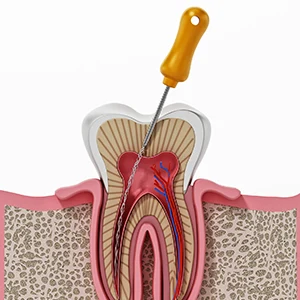If you’ve been experiencing persistent tooth pain or discomfort, a root canal treatment may be the best solution to save your natural tooth. While the thought of a root canal can seem intimidating, it’s a highly effective procedure that can relieve pain and preserve your smile. Understanding the three stages of root canal treatment can help you feel more confident and informed about the process.
Let’s explore the three stages of root canal treatment and explain each step in detail. Whether you’re considering a root canal or are simply looking to understand the procedure better, this guide will provide the clarity you need.

What is a Root canal?
A root canal is a dental procedure to treat infection or damage to the pulp (the soft tissue inside the tooth) and the surrounding area. The pulp contains nerves, blood vessels, and connective tissue. When the pulp becomes infected due to deep decay, injury, or repeated dental work, it can cause severe pain, swelling, and infection.
Here are 5 signs that you may need a root canal:
- Persistent Tooth Pain: Throbbing or severe tooth pain, especially when chewing or applying pressure, could be a sign of infection in the pulp.
- Sensitivity to Hot or Cold: Prolonged sensitivity to hot or cold that lingers after the stimulus is removed may indicate nerve damage or infection.
- Tooth Discoloration: If a tooth darkens or becomes discolored, it may be a sign that the pulp is damaged.
- Swollen or Tender Gums: Swelling or tenderness in the gums near a specific tooth, sometimes with a pimple-like bump, could indicate infection in the tooth.
- Pain When Touching or Biting: Experiencing pain when biting down or touching the tooth could suggest inflammation around the root, often requiring a root canal to save the tooth.
3 Stages of Root Canal Treatment
A root canal procedure involves three stages designed to address the infection and restore your tooth to full function. Here’s a breakdown of each stage:
Stage 1: Diagnosis and Preparation
Comprehensive Evaluation and X-rays
The first stage of root canal treatment begins with a thorough examination by your dentist or endodontist. If you are experiencing severe tooth pain, sensitivity to hot or cold, or swelling around the affected tooth, your dentist will evaluate the condition of your tooth and surrounding gums.
X-rays are taken to assess the extent of damage to the tooth and confirm whether the pulp (the innermost part of the tooth containing nerves and blood vessels) is infected. The X-ray also helps the dentist determine the number of canals in the tooth and how deep the infection has spread.
Local Anesthesia for Pain Relief
Once your dentist confirms that a root canal is necessary, local anesthesia is administered to ensure the area around the tooth is numbed. This allows the dentist to perform the procedure without causing discomfort. The anesthesia is very effective, so you should feel little to no pain during the treatment.
Stage 2: Cleaning and Shaping the Canal
Removing Infected Pulp
Once the tooth is numb, the dentist will begin the root canal procedure by creating a small access hole in the top of the tooth. This allows access to the infected pulp. The dentist will then use specialized tools to remove the infected pulp and clean the interior of the tooth. Removing the pulp is crucial as it eliminates the source of the infection and alleviates pain.
Cleaning and Shaping the Root Canals
After removing the pulp, the dentist carefully cleans and shapes the root canals to prepare them for filling. This process helps ensure that the canals are free of debris and bacteria. If necessary, the dentist may irrigate the canals with an antiseptic solution to further clean them and reduce the risk of further infection.
Stage 3: Sealing and Restoration
Filling the Root Canals
Once the canals are clean and shaped, they are filled with a biocompatible material called gutta-percha. This material helps seal the canals, preventing bacteria from entering and re-infecting the tooth. The dentist will carefully place the filling material inside each canal, ensuring the tooth is properly sealed.
Placing a Crown or Permanent Filling
After the root canal is sealed, the tooth may become more fragile and prone to breakage. Your dentist will likely recommend placing a dental crown over it to protect it. The crown will restore the tooth’s shape, size, and function, providing long-lasting protection. In some cases, if the tooth is relatively small or the decay is limited, a permanent filling may be sufficient instead of a crown.
Why Are the 3 Stages of Root Canal Treatment Important?
The root canal procedure is carefully divided into three essential stages to effectively address infection and restore the tooth’s health and functionality. Each stage plays a vital role in:
- Eliminating the Infection: The priority is to remove the infected pulp and prevent the spread of bacteria, ensuring that the infection doesn’t worsen or affect surrounding teeth.
- Relieving Pain: Root canal treatment helps alleviate the pain caused by inflammation and infection in the tooth’s pulp by cleaning and sealing the tooth.
- Restoring the Tooth’s Function: After the infection is cleared, the final step is to restore the tooth, often with a crown, ensuring it’s as strong and functional as before.
By carefully following these steps, root canal therapy can prevent the need for extraction, helping you preserve your natural tooth and maintain a healthy smile for years to come.
Conclusion
Root canal treatment may seem intimidating, but understanding the three key stages of the process can help you feel more confident about the procedure. From diagnosis and cleaning to sealing and restoration, each stage is designed to relieve pain, remove infection, and restore your tooth’s function. If you are experiencing any symptoms that might require a root canal, don’t hesitate to contact a dentist for a consultation. Early treatment can save your tooth and prevent further complications.
Book Your Consultation for a Root Canal Treatment Today
If you need a root canal or have questions about the procedure, book a consultation with us today. Our experienced team will guide you through the process and ensure you receive the best care for a comfortable, pain-free recovery. Don’t wait, preserve your smile with expert root canal treatment!
FAQs
How long does a root canal take?
A root canal takes 60 to 90 minutes for a single visit, depending on the complexity of the procedure and the number of canals that need to be treated. For more complicated cases, a follow-up visit may be required.
Is a root canal painful?
While many people believe that root canals are painful, the procedure is generally not as painful as it’s often made out to be. Local anesthesia ensures you are comfortable and pain-free during the procedure, and most patients experience minimal discomfort afterward.
How long does recovery take after a root canal?
After a root canal, most people experience only mild discomfort, which can be managed with over-the-counter pain relievers. Full recovery usually takes about 1-2 weeks. You can resume normal activities shortly after the procedure.
Will I need a crown after a root canal?
Yes, in most cases, a dental crown is placed over the treated tooth after a root canal to restore its shape, strength, and function. A crown helps protect the tooth from further damage and ensures that it remains durable and functional.
Can a root canal fail?
While root canal procedures are generally successful, they can fail if the infection isn’t fully removed or if the tooth develops new problems. However, the procedure is highly effective, and re-treatment can often resolve any issues.
Why do root canals take three visits?
Root canals take three visits if the infection is severe, the tooth has multiple canals, or a temporary filling is placed before the final restoration. Each visit allows for thorough cleaning, sealing, and crown placement.
What is the most painful stage of a root canal?
The most painful stage of a root canal is usually before the treatment, when the infection causes severe tooth pain. Once the tooth is numbed and the infected pulp is removed, most patients experience relief, with mild discomfort after the procedure.

